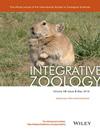酸化海水中微生物群落的变化:生活在意大利伊斯基亚二氧化碳喷口的多毛目环节动物的启示
IF 3.5
1区 生物学
Q1 ZOOLOGY
引用次数: 0
摘要
海洋吸收人类排放的二氧化碳会导致海洋酸化(OA),即海水pH值下降,对许多海洋生物造成负面影响。在这项研究中,我们调查了在自然酸化的二氧化碳喷口中发现的两种多毛类动物的微生物群落,它们是尼氏多毛类(Nereid Platynereis massiliensis complex)和栉水母类(Syllis prolifera)。研究人员在 Castello Aragonese(意大利那不勒斯湾,伊斯基亚岛)二氧化碳喷口的三个 pH 值降低的区域采集了动物。为了分析微生物组,在 Illumina MiSeq 平台上对 40 个蠕虫样本的 16S 核糖体 RNA 基因 V3-V4 超变区进行了测序。结果表明,两个物种的微生物阿尔法多样性没有差异。相反,在 pH 值正常的地点采集的蠕虫的微生物组成与在 pH 值较低的地点采集的个体有所不同。在酸化程度轻微但相关的地点采集的样本中,这种影响也很明显。报告显示,在不同 pH 值区域采集的样本组中,两种多毛目动物的扩增子序列变异有显著差异,但没有观察到共同的变异趋势。本研究加深了我们对海洋自然酸化地区多毛目动物微生物组组成的了解。我们的研究结果强调了未来研究 OA 引起的环境和多毛目动物微生物群落变化之间的联系以及这些变化对多毛目动物关键生物和生态特征的影响的重要性。本文章由计算机程序翻译,如有差异,请以英文原文为准。
Shifting microbial communities in acidified seawaters: insights from polychaetes living in the CO2 vent of Ischia, Italy
Oceans’ absorption of human‐related CO2 emissions leads to a process called ocean acidification (OA), consisting of the decrease of the seawater pH with negative consequences for many marine organisms. In this study, we investigate the microbial community of two species of polychaetes found in naturally acidified CO2 vents: the nereid Platynereis massiliensis complex and the syllid Syllis prolifera . Animals were collected in the CO2 vents of Castello Aragonese (Gulf of Naples, Ischia, Italy) in three zones at decreasing pH. For the analysis of the microbiome, the V3‐V4 hypervariable region of the 16S ribosomal RNA gene of 40 worm samples was sequenced on an Illumina MiSeq platform. No difference in the microbial alpha diversity of both species was highlighted. On the contrary, the microbial composition of worms collected in the site at normal pH was different from that of the individuals obtained from the sites at lower pH. This effect was evident also in samples from the site with a slight, but relevant, degree of acidification. Amplicon sequence variants showing a significant variation among the groups of samples collected from different pH zones were reported for both polychaetes, but no common trend of variation was observed. The present study deepens our knowledge about the composition of polychaete microbiome in marine naturally acidified sites. Our results stress the importance of future investigations about the connection between the variation of environmental and polychaete microbial communities induced by OA and about the effect of these variations on polychaete key biological and ecological traits.
求助全文
通过发布文献求助,成功后即可免费获取论文全文。
去求助
来源期刊

Integrative zoology
ZOOLOGY-
CiteScore
6.40
自引率
12.10%
发文量
81
审稿时长
>12 weeks
期刊介绍:
The official journal of the International Society of Zoological Sciences focuses on zoology as an integrative discipline encompassing all aspects of animal life. It presents a broader perspective of many levels of zoological inquiry, both spatial and temporal, and encourages cooperation between zoology and other disciplines including, but not limited to, physics, computer science, social science, ethics, teaching, paleontology, molecular biology, physiology, behavior, ecology and the built environment. It also looks at the animal-human interaction through exploring animal-plant interactions, microbe/pathogen effects and global changes on the environment and human society.
Integrative topics of greatest interest to INZ include:
(1) Animals & climate change
(2) Animals & pollution
(3) Animals & infectious diseases
(4) Animals & biological invasions
(5) Animal-plant interactions
(6) Zoogeography & paleontology
(7) Neurons, genes & behavior
(8) Molecular ecology & evolution
(9) Physiological adaptations
 求助内容:
求助内容: 应助结果提醒方式:
应助结果提醒方式:


